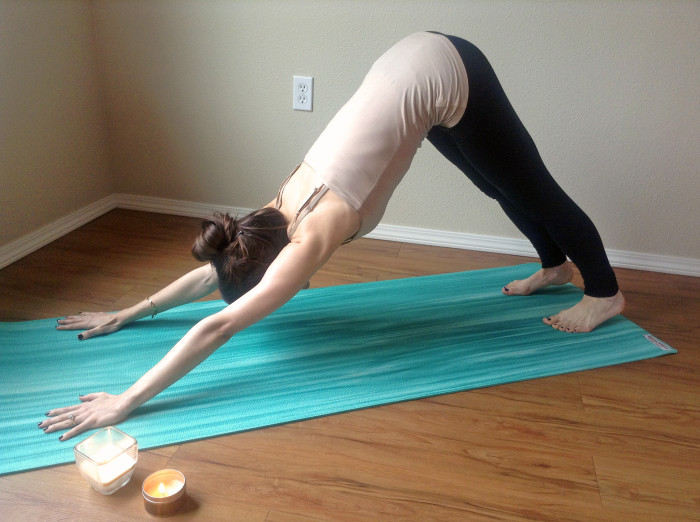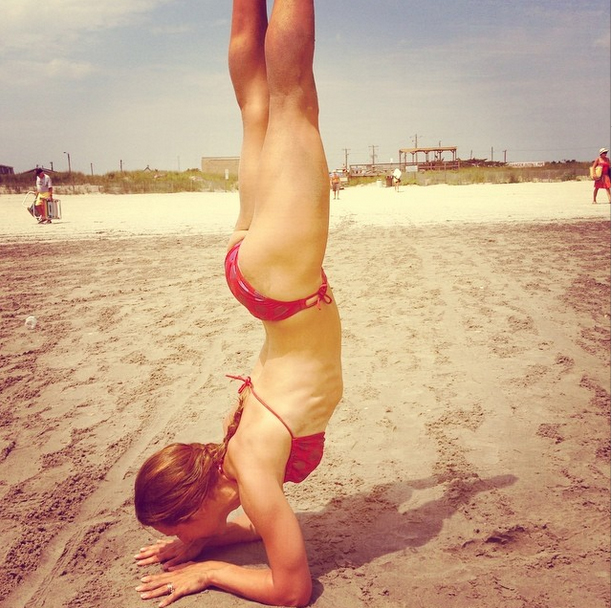Treat and prevent yoga wrist pain through mindful stretching and strengthening exercises.
Wrist pain can really take the fun out of yoga practice, especially for lovers of vinyasa, a style of yoga that usually incorporates chaturanga after chaturanga, i.e. a lot of weight bearing for the wrists! (In my experience, holding side plank or crow is particularly odious when your wrists are sore.)
Fortunately, whether your wrist pain is caused by yoga or some other oft-repeated activity, like typing all day, there’s a good chance that you can improve your wrist strength and flexibility over time to eventually avoid experiencing wrist pain during your yoga practice—and hopefully off the mat, too!
Why We Experience Wrist Pain in Yoga
Physical therapist and Iyengar yoga instructor Julie Gudmestad explains that most of us spend the majority of our waking hours with our wrists in “mild extension.” Full extension occurs when our hand and forearm are at roughly 90 degrees with the fingers pointing up (like the motion for “stop.”). Many yoga positions, including arm balances and some inversions, require the wrists to be in full extension, but since our non-yoga activities don’t condition our wrists in full extension, we’re likely to experience strain and soreness in the wrists once we demand that they support our body weight in full extension. More specifically, Gudmestad mentions, wrist pain in yoga is usually a sign of soft tissue strain, caused by the extension of the ligaments and tendons beyond their normal range.
How to Treat Wrist Pain and Avoid it in the Future
First, if weight-bearing poses are causing or exacerbating your wrist pain, it may be beneficial to simply take a break from them. It may take a few weeks to recover from your soreness, but there are a few measures you can take in the meantime.
Assess the flexibility of your wrists by coming into a hand-and-knees table-top position. Placing your hands directly under your shoulders, you’ll probably find that your wrists are at a 90-degree angle. If your wrists are not comfortable in this position, you can gradually work to increase your wrist flexibility by starting out in table-top with your wrists at a gentler angle (i.e., your hands may be placed closer to the top of the mat). Over the course of several days, gently practice decreasing the angle of your wrist (so it’s closer to 90 degrees) until you feel more comfortable in the original table-top position.
I also recommend trying this series of wrist-strengthening poses published by Yoga International. These simple exercises will help increase the range of motion in your wrist while strengthening the muscles in your shoulders and upper back.
Iyengar expect Doug Keller encourages practitioners to strengthen the lower forearm muscles, which are typically underworked in everyday activities. When the lower forearm is too weak, weight may be excessively distributed to the wrist. To strengthen your entire forearm, Keller suggests doing first curls: Simply make a loose fist with your palm facing upward; then, curl your fist, bringing your palm to face the floor. Include a 1-2 pound dumbbell to increase the intensity of the exercise if desired.
When you’re ready to return to weight-baring positions, take it slowly. You may want to limit yourself to only a few sun salutations during the first week of your practice after taking a break. Also, you can modify weight-bearing poses by finding various ways to more evenly distribute your weight across your body. For example, doing chaturanga from your knees rather than your toes will decrease the amount of weight put on your hands.
Furthermore, as you return to your regular practice, consider adjusting the way you bear weight on your hands. Yoga by Candace recommends avoiding dumping weight at on the heels of your hands. Rather, keep the area between your thumb and forefinger tracking towards the floor, and press into the bottom and top of the thumb, bottom and top of the forefinger, and bottom of the pinky. Concentrating the pressure across your hand should help you build forearm strength while minimizing the strain put on the wrists.
Yogis can also use props to modify certain positions. Yoga instructor Megan Chambley details how to create a chaturanga hammock using a strap. This modified pose allows practitioners to focus on proper alignment in this weight-bearing asana and avoid repetitive strain injury (RSI) to the wrists.
Note: If these gentle methods to decrease and prevent wrist pain cause additional pain it may be best to consult a healthcare professional. Additionally, possible complications, like carpal tunnel syndrome or a history of wrist fracture, should be addressed with your doctor before you attempt any weight bearing exercises.
Have you come across any tips for preventing or treating wrist pain through yoga?
Related: When to Take a Break from Yoga – A Teacher’s Perspective
5 Yoga Exercises to Correct Rounded Shoulders
Get more like this–sign up for our newsletter for exclusive inspirational content!
Photo: Mary Hood Luttrell





